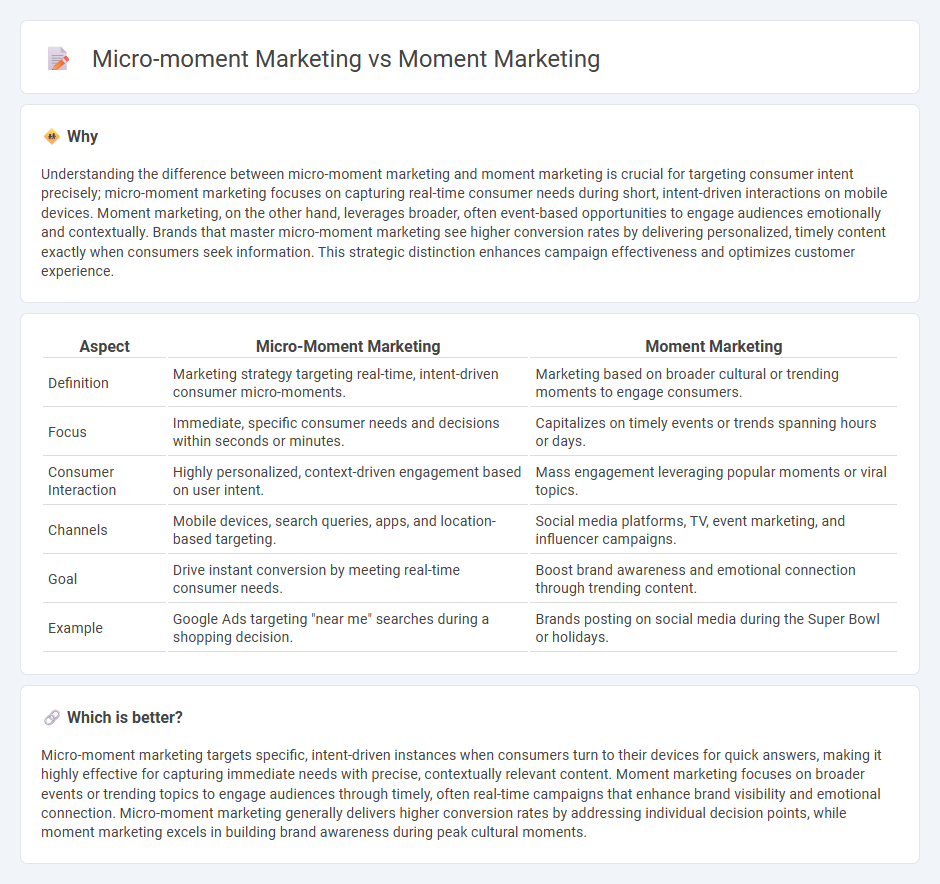
Micro-moment marketing targets specific, intent-driven moments when consumers turn to their devices for quick answers or decisions, emphasizing real-time engagement and personalized content. Moment marketing, by contrast, leverages broader timely events or trending occasions to connect with audiences on a large scale through relevant campaigns and promotions. Explore the differences and benefits of these strategies to elevate your marketing effectiveness.
Why it is important
Understanding the difference between micro-moment marketing and moment marketing is crucial for targeting consumer intent precisely; micro-moment marketing focuses on capturing real-time consumer needs during short, intent-driven interactions on mobile devices. Moment marketing, on the other hand, leverages broader, often event-based opportunities to engage audiences emotionally and contextually. Brands that master micro-moment marketing see higher conversion rates by delivering personalized, timely content exactly when consumers seek information. This strategic distinction enhances campaign effectiveness and optimizes customer experience.
Comparison Table
| Aspect | Micro-Moment Marketing | Moment Marketing |
|---|---|---|
| Definition | Marketing strategy targeting real-time, intent-driven consumer micro-moments. | Marketing based on broader cultural or trending moments to engage consumers. |
| Focus | Immediate, specific consumer needs and decisions within seconds or minutes. | Capitalizes on timely events or trends spanning hours or days. |
| Consumer Interaction | Highly personalized, context-driven engagement based on user intent. | Mass engagement leveraging popular moments or viral topics. |
| Channels | Mobile devices, search queries, apps, and location-based targeting. | Social media platforms, TV, event marketing, and influencer campaigns. |
| Goal | Drive instant conversion by meeting real-time consumer needs. | Boost brand awareness and emotional connection through trending content. |
| Example | Google Ads targeting "near me" searches during a shopping decision. | Brands posting on social media during the Super Bowl or holidays. |
Which is better?
Micro-moment marketing targets specific, intent-driven instances when consumers turn to their devices for quick answers, making it highly effective for capturing immediate needs with precise, contextually relevant content. Moment marketing focuses on broader events or trending topics to engage audiences through timely, often real-time campaigns that enhance brand visibility and emotional connection. Micro-moment marketing generally delivers higher conversion rates by addressing individual decision points, while moment marketing excels in building brand awareness during peak cultural moments.
Connection
Micro-moment marketing focuses on capturing consumers' attention during brief, intent-rich moments throughout their daily activities, leveraging real-time data to deliver personalized content. Moment marketing builds on this by targeting specific events or cultural occurrences to create relevant, timely campaigns that resonate emotionally with the audience. Both strategies rely on responsiveness and contextual relevance, enhancing engagement and driving conversions by addressing consumer needs precisely when they arise.
Key Terms
**Moment Marketing:**
Moment marketing targets broad, timely events or trends to capture consumer attention with relevant promotions, often leveraging real-time social media engagement during major occasions like holidays or sports events. It emphasizes aligning brand messages with widely recognized moments to boost visibility and spur immediate consumer action. Explore how moment marketing strategies can elevate your brand's responsiveness and resonance in dynamic markets.
Real-time Engagement
Moment marketing centers on leveraging timely events and trends for brand promotion, while micro-moment marketing zeroes in on capturing consumer intent during specific, real-time decision-making instances. Both strategies emphasize real-time engagement through timely, personalized messaging that meets consumers exactly when they are most receptive. Explore how mastering these tactics can significantly elevate your brand's responsiveness and customer connection.
Trending Events
Moment marketing leverages real-time trending events to create relevant and timely content that resonates with the audience's current interests, driving immediate engagement and brand visibility. Micro-moment marketing zeroes in on consumers' intent-driven, instantaneous decisions during specific, often mobile-driven moments, delivering precise information or offers relevant to the exact need. Explore how aligning your strategy with trending events can enhance brand responsiveness and customer interaction with both moment marketing and micro-moment marketing approaches.
Source and External Links
5 Ways to Boost Your Brand Engagement with Moment Marketing - Moment marketing is a strategy where brands capitalize on current trends, news, or events to boost awareness and sales by delivering the right message at the right time, often involving timely and creative responses to trending topics for maximum engagement and relevance.
Moment Marketing: 10 Examples & Case Studies You Need To Know - Moment marketing involves leveraging timely and culturally relevant events to connect emotionally with consumers, increasing engagement, reach, customer loyalty, and ROI through flexible and creative campaigns tailored to current interests.
What is moment marketing and how can you use it? - Adobe - Moment marketing is a fast-paced, reactive form of advertising where businesses boost brand awareness by tapping into current events and trends, offering cost-effective opportunities for higher engagement, greater reach, and stronger customer loyalty, especially via platforms like TikTok, YouTube, and Instagram.
 dowidth.com
dowidth.com